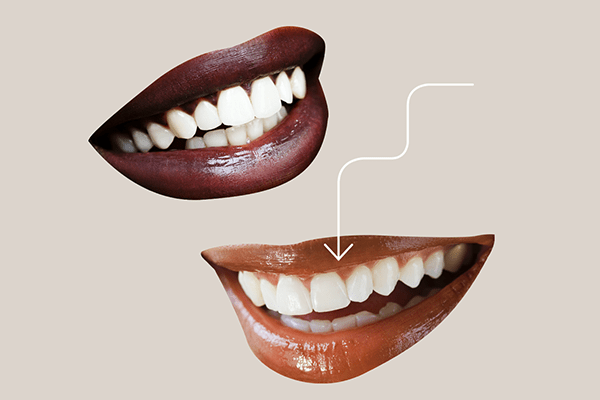- What are dental veneers?
Dental veneers are thin shells made of porcelain or resin composite materials that are custom-made to fit over the front surface of a tooth. They are used to improve the appearance of teeth that are discolored, stained, chipped, misaligned, or have gaps between them. The veneers are bonded to the front of the teeth and can dramatically improve the smile’s overall appearance. Dental veneers are a popular cosmetic dentistry treatment and offer a long-lasting solution for enhancing the appearance of the teeth.
- When are veneers prescribed?
Dental veneers are usually prescribed when a person wants to improve the appearance of their teeth and smile. They are typically recommended for the following conditions:
- Discoloration: Veneers can be used to improve the appearance of teeth that are severely discolored or stained and cannot be treated with teeth whitening procedures.
- Chipped or broken teeth: Veneers can be used to repair teeth that have been chipped or broken and restore their natural appearance.
- Misaligned teeth: Veneers can be used to correct minor misalignment issues, such as teeth that are slightly crowded or have gaps between them.
- Worn down teeth: Veneers can be used to restore the appearance of teeth that have been worn down over time due to chewing, grinding, or biting habits.
- Uneven teeth: Veneers can be used to even out the appearance of teeth that are uneven in shape or size.
In some cases, veneers may also be recommended to protect the front surface of a tooth that is weakened by decay or other damage.
It is important to note that veneers are a cosmetic treatment and are not always necessary for good oral health. A dentist can evaluate a patient’s needs and recommend the best treatment option for their specific case.
- Pros and cons of veneers
Pros:
- Improved Appearance: Dental veneers can dramatically improve the appearance of teeth that are discolored, stained, chipped, misaligned, or have gaps between them.
- Durability: Veneers are typically made from porcelain or resin composite materials, which are durable and long-lasting. With proper care, veneers can last for many years.
- Non-invasive: Veneers are a minimally invasive procedure and do not require extensive tooth preparation. In many cases, only a small amount of tooth structure needs to be removed to make room for the veneer.
- Customizable: Veneers can be customized to match the color, shape, and size of a patient’s natural teeth. This allows for a natural-looking and seamless result.
- Easy to Maintain: Veneers are easy to care for and maintain with regular brushing, flossing, and dental check-ups.
Cons:
- Cost: Veneers can be expensive, and the cost can vary depending on the number of teeth being treated, the material used for the veneers, and the location of the dentist’s practice.
- Tooth Removal: In order to place veneers, a small amount of tooth structure may need to be removed. This can cause some sensitivity, especially for those with thinner teeth.
- Not Reversible: Once a tooth has been prepared for a veneer, the process is not reversible. This means that if a patient is unhappy with the results, they will need to undergo additional treatment to correct the issue.
- Limited Longevity: Although veneers are durable, they are not permanent and may need to be replaced over time.
- Maintenance: Veneers are susceptible to staining and discoloration, just like natural teeth. It is important to maintain good oral hygiene and avoid habits that can damage the veneers, such as biting on hard objects or grinding the teeth.
- Procedure for fixing veneers
The procedure for fixing veneers will depend on the specific issue and the type of veneer being used. However, here is a general overview of the process for fixing veneers:
- Evaluation: The dentist will evaluate the veneer and determine the cause of the issue, such as a loose or broken veneer.
- Cleaning: The tooth and surrounding area will be thoroughly cleaned to ensure a secure bond.
- Preparation: If necessary, the dentist may need to prepare the tooth by removing any decay or reshaping the tooth to make room for the veneer.
- Bonding: The veneer will be carefully positioned over the tooth and the dentist will use a special bonding material to attach it to the tooth. The bonding material will be cured with a special light, which will harden the material and secure the veneer in place.
- Polishing: Once the bonding material has cured, the dentist will polish the veneer to ensure a smooth and natural-looking finish.
- Follow-up: The dentist will schedule a follow-up appointment to check the veneer and make sure it is functioning properly.
It is important to keep in mind that the process for fixing veneers can vary depending on the specific case, and the dentist will provide specific instructions based on the patient’s needs.













